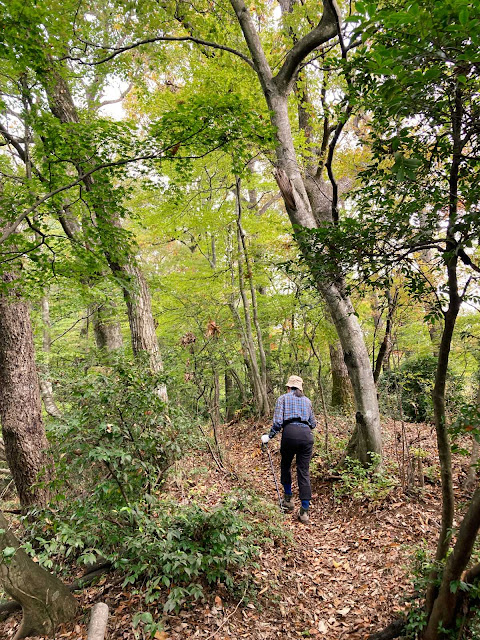Ascending this miniature Meizan by its northern flank, you pass by places such as Murodō and Ōnanji, names that echo those on the sacred mountains of Tateyama and Hakusan. But today we dispense with this cultural baggage by taking the west ridge. From a layby at the end of the road, a muddy runnel leads up into the woods.
No shrines or jizō statues are met with until we reach the Oku-no-in (“Inner sanctuary”). Here a gigantic split boulder goes by the name of Tainai, like the famous lava caves at the foot of Mt Fuji.
Leaving the Sensei to take a rest, I step over a col to the summit shrine. The wooden fane has been magnificently rebuilt, after a typhoon shoved it bodily from its foundations a few years ago.
A new signboard promotes Monju's connection with the Hyakumeizan story – it records that Fukada Kyūya, then in his fourth year at Fukui Middle School, came up here with three companions in November 1919 and inscribed their names inside the shrine.
How exactly these graffiti have been preserved is unclear – are they still in situ inside the shrine’s doors, or have they been taken down to some archive or museum? I’d like to take a closer look, but people keep coming up to pay their respects to the shrine.
Another signboard attracts my attention, this one revealing a darker side to Monju’s history. Meizan or not, the mountain served as a fortress during the Warring Country period, to either defend or subjugate the people below, depending on your viewpoint.
How exactly these graffiti have been preserved is unclear – are they still in situ inside the shrine’s doors, or have they been taken down to some archive or museum? I’d like to take a closer look, but people keep coming up to pay their respects to the shrine.
Another signboard attracts my attention, this one revealing a darker side to Monju’s history. Meizan or not, the mountain served as a fortress during the Warring Country period, to either defend or subjugate the people below, depending on your viewpoint.
As an army veteran himself, the Hyakumeizan author had no illusions about the military usefulness of mountains. After he has expatiated on the medicinal herbs of Ibuki (1,377 metres), for example, the summit view prompts these thoughts:
The plain looked so peaceful, yet it was precisely there, in the Genki and Tenshō eras (1570-1592), that the most bloody battles had taken place. Right in front of my eyes lay the killing fields of Shizu-ga-dake, Anegawa, and Sekigahara. Looking at the little hills spread out below, I could imagine how the generals of old found this ideal terrain on which to practice their deadly stratagems.
Well, it was probably naïve to have overlooked the strategic potential of this well-placed Meizan, I tell myself as I aim my phone camera at the signboard. In peace time, we tend to forget that mountains have other uses besides hiking, climbing and collecting herbs.
Just then, atop the sign’s supporting post, I notice a dragonfly basking in the sun. The strangest thing, though – did it just wink at me ... ?






No comments:
Post a Comment